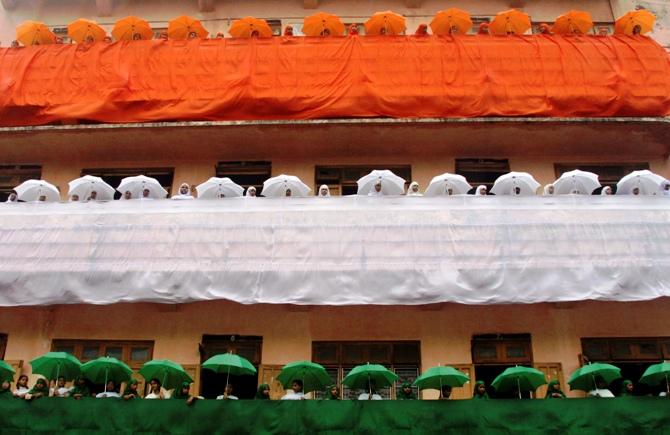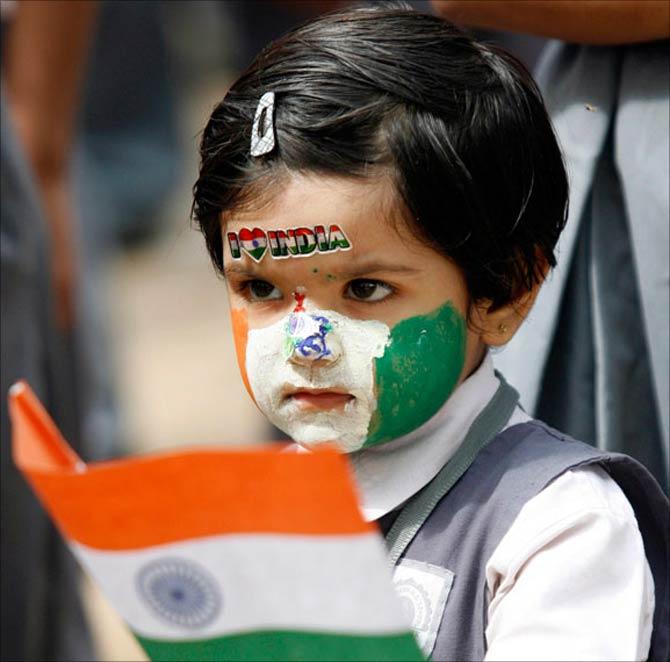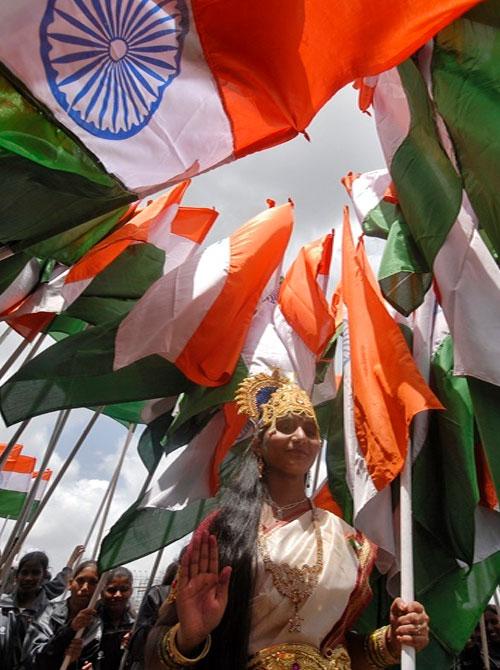Photographs: Amit Dave/Reuters A K Bhattacharya
If the government has to take its public expenditure reform plan to its logical conclusion, the next step should be to reduce the headcount of ministries that have seen a cut in their central Plan outlay, notes AK Bhattacharya
What has the total outlay of a central ministry to do with its manpower?
The question is not irrelevant, since there is a clear correlation between any department and its headcount of employees.
For instance, the size of a central ministry’s annual outlay should ideally be a key factor in determining the number of people who need to be employed by it.
If the outlay is reduced, the headcount should also decline proportionately.
So, when the budgeted estimate of expenditure for many central ministries declines by varying margins from next year, what should happen to their oversized staff strength?
That precisely is the big question that Palaniappan Chidambaram’s interim Budget for 2014-15 has raised and nobody has as yet found an answer to it, let alone gauge the potential impact of his financial allocations for next year on the clout -- indeed the future -- of about half a dozen central ministries.
. . .
What the govt needs to do to cut expenses
Image: Indian Air Force sky divers form the Indian tri-colour at Hindon airport in Ghaziabad.Photographs: Adnan Abidi/Reuters
The fact is that the big story of Mr Chidambaram’s Interim Budget is not just about his excise giveaways for manufacturers of automobiles, capital goods and consumer durables or the Rs 75,000-crore (Rs 750-billion) cut in this year’s budgeted expenditure to contain the fiscal deficit within 4.6 per cent of gross domestic product.
An equally big, and perhaps more important, story of his interim Budget pertains to the major changes in the government’s public expenditure management.
What this simply means is that more Plan money is now routed to the states directly by way of central assistance.
Consider the extent of this change.
In the current financial year ending March 2014, the Union government transferred Rs 1.19 lakh crore (Rs 1.19 trillion) to the states and Union territories by way of central assistance to help them finance their individual plans.
. . .
What the govt needs to do to cut expenses
Image: A girl with her face painted in colours of the Indian national flag.Photographs: Reuters
Next year, this amount is slated to go up by 184 per cent to Rs 3.39 lakh crore (Rs 3.39 trillion).
Correspondingly, the Union government’s Budget support of its central Plan will decline to Rs 2.17 lakh crore (Rs 2.17 trillion) next year, a drop of about 40 per cent over the current year’s Budget support.
The drop will be somewhat lower, at around 24 per cent, when you include the internal and extra-budgetary resources of public sector enterprises in the Plan outlay amount for all the central ministries.
Clearly, the public sector’s resource-raising efforts have been used to make good part of the decline in the Centre’s budgetary support for its Plan.
. . .
What the govt needs to do to cut expenses
Photographs: Reuters
The ostensible reason for such a major increase in central assistance to states and Union territories is to ‘infuse greater ownership of Plan schemes to state and Union territories governments and greater accountability on them to make timely and need-based releases to local implementing agencies and also monitor the implementation of schemes more closely’.
While this will be hailed as a bold move towards greater decentralisation, economic federalism and financial accountability, the corollary of this experiment has led to a sharp drop in the availability of Plan funds for quite a few central ministries.
Thus, the central plan outlay for next year has seen a huge decline of about 70 per cent to Rs 7,726 crore (Rs 77.26 billion) for the ministry of health and family welfare.
The drop in the outlay for some other central ministries is also huge, such as 73 per cent for the ministry of human resource development (which oversees the implementation of the Sarva Shiksha Abhiyan) to Rs 16,777 crore (Rs 167.77 billion); almost 88 per cent for the ministry of rural development (which implements the Mahatma Gandhi National Rural Employment Guarantee scheme) to Rs 7,614 crore (Rs 76.14 billion); and 46 per cent for the ministry of agriculture to Rs 8,769 crore (Rs 87.69 billion).
. . .
What the govt needs to do to cut expenses
Photographs: Reuters
The question that arises now is: what happens to the number of people who are employed in the ministries that have seen such a huge cut in their outlays?
More than 26,000 employees are on the rolls of the ministry of health and family welfare. If the financial outlay is cut by 70 per cent, how can the ministry bear the burden of such a large workforce?
The ministry of agriculture has close to 10,000 employees in its different departments and can hardly justify that workforce after its outlay has been cut almost by half.
The ministry of rural development, with about 760 employees, is relatively well placed in this regard.
The department of school education and literacy, which bears the brunt of the outlay cut for the ministry of human resource development, has about 430 employees.
. . .
What the govt needs to do to cut expenses
Photographs: Reuters
If the government has to take its public expenditure reform programme to its logical conclusion, which it should, the next step should be to put in place an action plan to reduce the headcount of at least ministries that have seen a cut in their central Plan outlay.
If that plan is not implemented, the larger goal of efficient utilisation of scarce resources will be defeated.
The total number of people employed in central ministries (excluding the Indian Railways) is at present estimated at over 2.24 million and is likely to go up to 2.3 million next year.
With a total wage bill of Rs 82,625 crore (Rs 826.25 billion) for these employees (as budgeted for next year), this is one expenditure head that the government cannot ignore now, particularly after having initiated the more difficult phase of expenditure reform. Perhaps, the next government that is to be formed later this year should get ready for that challenge.








article